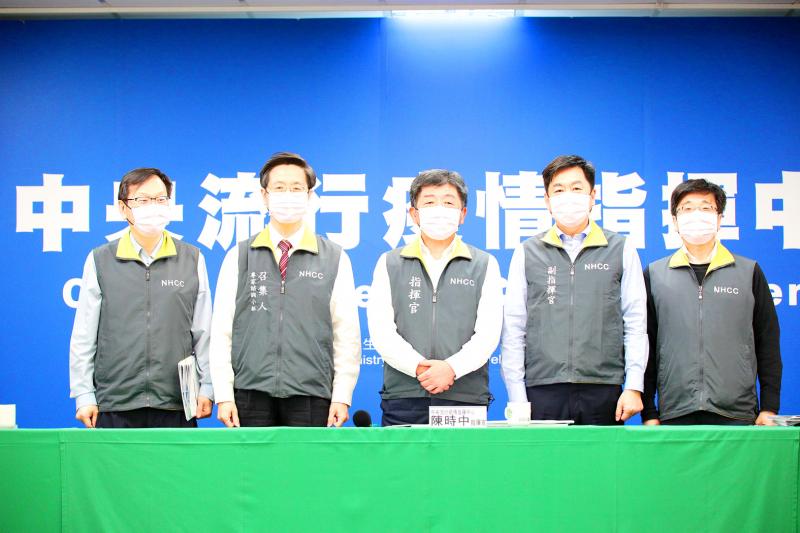Pink is the new black again. In response to media reports of parents complaining that their sons were unwilling to wear pink masks to school, Minister of Health and Welfare Chen Shih-chung and top health authorities all wore pink masks at a regular news conference last week to show support for schoolboys who were mocked for wearing “girly” colored masks.
Chen said masks in all colors are the same, and pink masks look just fine, adding that his favorite cartoon character, the Pink Panther, is pink. His remarks have caused a “pink fever” in Taiwan, as officials and celebrities including President Tsai Ing-wen, Taiwanese pitcher of the Seattle Mariners Chen Wei-yin, and world No. 1 badminton player Tai Tzu-ying posted photos of themselves wearing pink masks.
Buyers cannot choose the color or pattern of masks under Taiwan’s rationing policy. Since most masks are plain colors, one netizen has attracted attention by posting masks with national flag designs that she bought from a pharmacy in New Taipei City.

Photo: CNA 照片︰中央社
(Eddy Chang, Taipei Times)
粉紅色再度蔚為風潮!為了回應媒體報導有家長反映,他們的兒子不願意戴粉紅色口罩上學,衛福部部長陳時中和衛生主管上週在某例行記者會上,全體戴上粉紅色口罩,力挺因戴上所謂較女性化顏色口罩而被嘲笑的男學生。
陳時中強調所有顏色的口罩都可以戴,粉紅色也不錯,他最喜歡的卡通人物——粉紅豹——正好是粉紅色。這番話在台灣引起一股「粉紅熱」,多位官員、名人,從蔡英文總統,到水手隊台灣強投陳偉殷及世界羽球球后戴資穎等人,紛紛貼出他們戴著粉紅色口罩的照片。
在台灣目前的限量配給政策下,購買者均無法挑選口罩的顏色或花紋。由於大部分的口罩都是素色的,一位網友曬出她在新北市某藥房買到的國旗圖案口罩,立刻吸引到不少目光。
(台北時報張聖恩)

★ Bilingual Story is a fictionalized account. 雙語故事部分內容純屬虛構。 “Any New Year’s resolutions?” he asked. Lena put her coffee down. “Yeah,” she said. “To get in shape.... round is a shape, right?” Mark chuckled. “I support this. Fully achievable. Low risk.” “Thanks,” she smiled and lovingly rubbed her round belly. “I like a resolution I can’t fail.” “Funny thing is, I was thinking about getting round too.” Lena nodded her head in approval, “You could put some meat on those skinny bones of yours.” Mark shook his head, “Not that kind of round. Wheel-of-Life round.” She raised an eyebrow.

詞法—不定詞的誤用 1. 我得記住星期五要把報告寫好。 ˇ I must remember to finish my report by Friday. χ I must remember finishing my report by Friday. 註︰remember 後面跟動名詞或不定詞表示兩種不同的概念,與 forget 相類似。 試比較下列句子: I remember meeting him somewhere.(我記得曾經在某處見過他。) I must remember to meet him at the station at six this evening. (我必須記住今晚六點得去車站接他。) He remembered turning off the light when he left the room. (他記得離開房間時曾先把燈熄了。) Remember to turn off the light when you leave the room. (記住離開房間時要把燈關了。) 2. 他提醒她做好她份內的事。 ˇ He reminded her to do her job. χ He reminded her of doing her job. 註︰remind ... of ... 後面跟動名詞,表示「使人想起做過某事」。若是「提醒某人應做某事」,應用 remind ... to do ...。試比較下列句子: He reminded me of my attending the lecture last Friday. (他讓我想起我上星期五去聽過那次演講。) He

對話 Dialogue 清清:最近天氣越來越冷,感覺很容易感冒,要不要一起去吃薑母鴨或是羊肉爐? Qīngqing: Zuìjìn tiānqì yuèláiyuè lěng, gǎnjué hěn róngyì gǎnmào, yào bú yào yìqǐ qù chī jiāngmǔyā huòshì yángròulú? 華華:最近我覺得有點累,想吃薑母鴨,可是又怕一下子吃太補會上火。 Huáhua: Zuìjìn wǒ juéde yǒudiǎn lèi, xiǎng chī jiāngmǔyā, kěshì yòu pà yíxiàzi chī tài bǔ huì shànghuǒ. 清清:那我們去喝香菇雞湯吧,不太容易上火,喝了也會很暖和。 Qīngqing: Nà wǒmen qù hē xiānggū jītāng ba, bú tài róngyì shànghuǒ, hē le yě huì hěn nuǎnhuo. 華華:聽起來不錯!你們家平常冬天都吃什麼進補? Huáhua: Tīng qǐlái búcuò! Nǐmen jiā píngcháng dōngtiān dōu chī shénme jìnbǔ? 清清:我家都煮麻油雞,吃完整個人手腳都會熱起來。我也很久沒喝香菇雞湯了,正好可以去打打牙祭。 Qīngqing: Wǒ jiā dōu zhǔ máyóujī, chī wán zhěnggè rén shǒujiǎo dōu huì rè qǐlái. Wǒ yě hěn jiǔ méi hē xiānggū jītāng le, zhènghǎo kěyǐ qù dǎ dǎ yájì. 華華:可是我最近在減肥,會不會吃得太補,肉又長回來了? Huáhua: Kěshì wǒ zuìjìn zài jiǎnféi, huì bú

A: Apart from Taiwan’s A-mei, Mayday and Jolin Tsai, there are many foreign singers coming to Taiwan early this year. B: The South Korean girl group Babymonster are playing two shows at Taipei Arena starting from tonight. Who else is coming to Taiwan? A: Other artists include Australian band Air Supply, K-pop superstar Rain, boy group Super Junior, TXT, US singers Giveon and Josh Groban, and Irish boy group Westlife. B: Air Supply was the first foreign band to come to Taiwan in 1983, and they’re probably the most frequently visiting group too. A: As the year is beginning